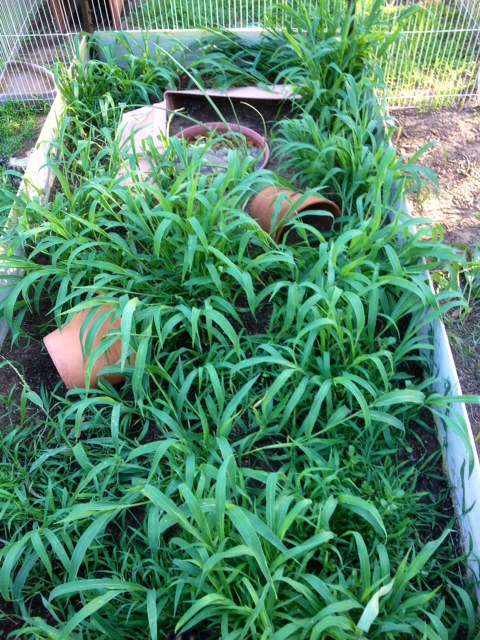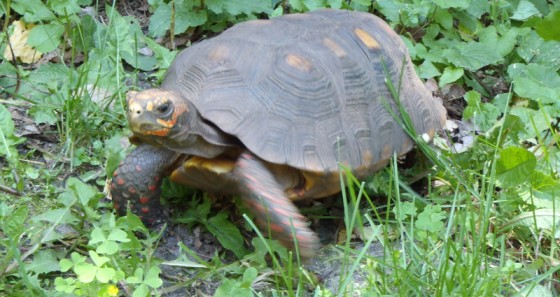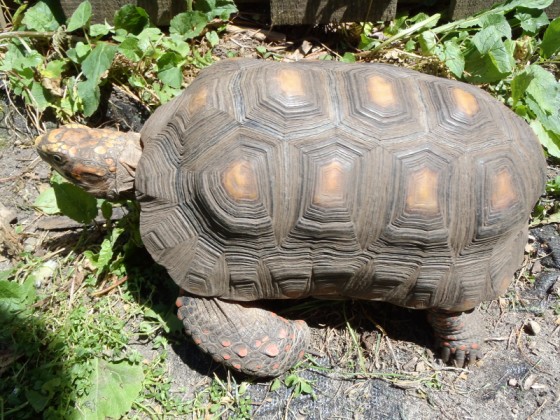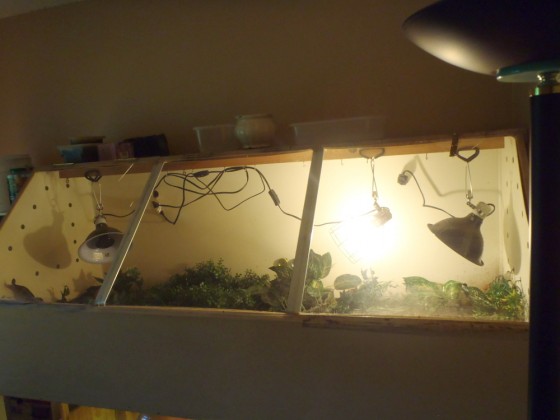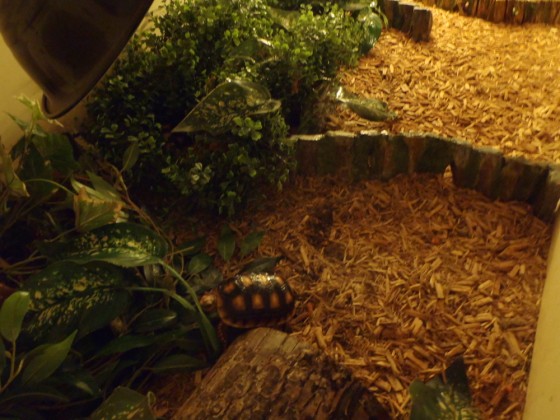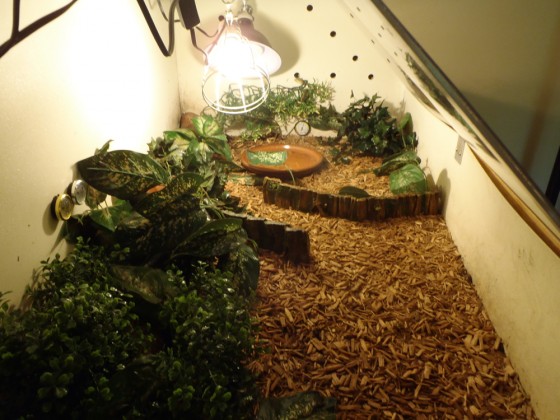When it comes to the Redfoot tortoise one of the biggest mistakes people have come to believe is they live in open savannah areas in the wild. Most of this comes from a few observations by well known and reputable scientists.
I’m going to turn this thinking on its head by pointing out some basic, but critically important topographic and geologic Redfoot tortoise facts, that will help you create the right indoor and outdoor enclosures and diet so your Redfoot tortoise lives a long, healthy life.
I’m going to use my adult Redfoot’s and where their parents (mine are captive bred) are from as the example. The origin country of my adults is Guyana, a country on the northeastern coast of South America.
The Topography of The Redfoot Tortoise Native Environment
The overall topography of Guyana, as you can see from this graphic, is roughly 85% dense Tropical forest.
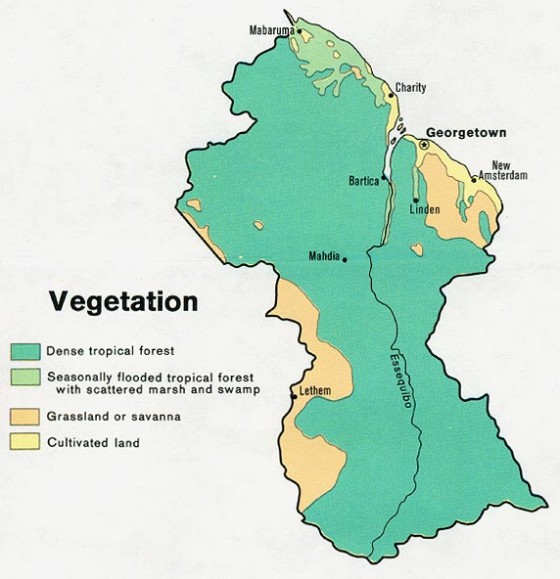 Savannah areas make up about 10-15% of the country.
Savannah areas make up about 10-15% of the country.
So, with 85% of the country of Guyana covered in dense tropical forest where do you think 85% or more of all the wild Redfoot tortoises in Guyana live?
You got it – in dense tropical forest.
It’s much easier to observe those few tortoises who wander out into the 10-15% of the open areas looking for food than to find the multitude who stay in the dense forest, where getting around for people is more difficult and dangerous.
If you look at the topography of all the countries where the Redfoot tortoise is a native species, they all have 70+% of the country covered in dense tropical forest. Guyana is not an outlier.
Another important fact to consider is the narrow temperature band in all these countries where a 70-90 degree range over the year is typical, with a humidity range virtually the same at 70-90%.
These countries have two seasons – wet and dry.
Another important, and obvious, but overlooked fact is the color of the Redfoot carapace. It’s navy, dark brown or almost black. So, with a narrow temperature range and a very dark carapace what need would the Redfoot tortoise have to bask in the sun like a Russian or Greek?
The dark carapace would warm them up very quickly (because dark colors absorb heat) as well as overheat them just as quickly in bright sunshine.
All of the arid species of tortoises who live in areas with very little ground cover, lots of sunshine, and a wide temperature range have lighter colored carapaces. It’s because light colors reflect heat.
Redfoot tortoises live their entire life where the need to warm up to a “normal operating temperature” isn’t necessary because it doesn’t get cool enough to lower their internal temperature where it would impede normal operation.
These are Forest tortoises, like there close relative the Yellowfoot (who spend their entire life in the forest), not arid area tortoises.
Now, understanding this has implications to the housing you need to provide for your Redfoot tortoise, as well as their diet.
First, for indoor and outdoor Redfoot tortoise enclosures setting up a pen like one a Russian, Greek, or Hermann’s would thrive in (open, lots of sunshine, and a hide) is not what these tortoises need and is all too often what I see in YouTube videos and on Facebook pages.
In that type of setup keeping the temperature between 70 and 90 degrees let alone the humidity between 70 and 90% is extremely difficult unless you soak it down 5-6 times a day.
Your Redfoot enclosures, be they indoor or outdoor, should mimic their natural habitat and have 70-75% of the pen area covered in plants. Plastic ones work best for indoor pens because they don’t get eaten and you can find plenty of them at your local Goodwill for pennies on the dollar.
Here’s an excellent example of an outdoor enclosure for 1 year to 6 year old Redfoot’s. It’s from a customer of ours in the greater San Antonio, Texas area.
One or two simple 20-40 watt LED bulb that puts out no heat and will last for years, along with one or two 100 watt heat emitters is perfect for a 4 foot by 8 foot indoor Redfoot enclosure.
The heat emitters help simulate the warmth of the forest were temperatures only fluctuate 5-10 degrees year round.
Cover the top of the pen with Plexiglas sheets supported by wood beams and you have a simple way to not only keep the temperature 70-90 degrees year round, but by misting once a day also keep the humidity at 60-80% as well.
That’s been my exact set-up for my now adult Redfoot’s for many years.
For outdoor pens large hosta plants work well for cover as most Redfoot’s won’t eat the leaves, even though they’re perfectly fine as a food item. Hibiscus plants are another perfect cover item in outdoor pens if you live in an area where they can live outside year round. Their leaves and flowers are also a fantastic tortoise food item.
The Redfoot Diet and the Geology of Their Native Habitat
A critical piece to understanding the diet of the Redfoot vs. Russian’s, Greek’s and Hermann’s is the underlying geologic structure of the Mediterranean (the natural environment of Russian’s, Greek’s and Hermann’s) which is a gigantic limestone bed. In all the areas where arid species of tortoises are native, limestone is the major mineral of the underlayment. This results in native plant species (the major dietary component of arid torts) having a very high calcium content and why tortoises in those areas developed and thrived in the first place.
Contrast that with the underlying geologic structure of southern Central America and northern South America, (the native range of the Redfoot tortoise), which has only small, discontinuous pockets of limestone in the underlayment.
Since the plant species and fruit trees of this area don’t have any significant calcium concentration, how do Redfoot’s get calcium?
They get it through their consumption of animal protein and mammal feces. Redfoot’s are omnivorous. They fill roughly the same ecological niche as the Eastern Box turtle of this country, so their respective diets have very similar components- insects, carrion, fruit, mushrooms, etc.
The Redfoot tortoise gets its calcium by consuming carrion, insects, and mammal feces. All three of those items have both calcium and vitamin D3. D3 is the mechanism that allows calcium to be processed by the body. They don’t process via sunshine on the skin, which is the mechanism used by arid tortoise species – and humans.
I have never had a UVB bulb for my now 12+ year old captive bred adult Redfoot’s and they are perfectly healthy with solid shells, have only the smallest bit of stacking, and have produced over 25 healthy, perfectly normal hatchlings the last three years.
You can see them below.
Male
If what I’ve laid out above wasn’t true, they wouldn’t be as healthy as they are and certainly couldn’t produce healthy, normal hatchlings.
You can see all of the 2011 and 2012 hatchlings on the Currently Available page.
So, when you consider getting a Redfoot or have one and think the enclosure you have is the right one, consider the above and do your tortoise and yourself a favor by mimicking their natural environment and diet and enjoy a healthy, long term pet.
